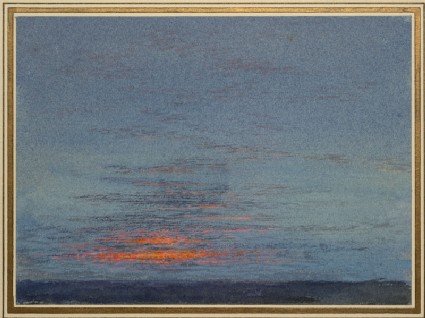Ruskin's Educational series, 2nd ed. (1874)
Ruskin's revised catalogue of 300 works for the instruction of undergraduates and his notes on the use of particular examples.

Ruskin's Catalogues: 32 objects
- Reference URL
Actions
Study of Dawn: the first Scarlet on the Clouds John Ruskin
-
Ruskin text
3 Study of Dawn. The first scarlet on the clouds.M -
Curator’s description:
Description
Above a level band of blue-grey horizon, the pale blue sky is streaked with wispy, thin, dark clouds, which reflect the bright orange rays of the rising sun in the lower centre-left. This is the first of a group of three watercolours, of similar size on blue-grey paper, depicting early morning skies at Denmark Hill in March 1868. (The others are nos 4 and 5 in the Educational Series.)
The work was first catalogued in 1871, in the first Educational Series catalogue, as no. 3 A; it remained in the same position in the second Educational Series catalogue, and in Ruskin's 1878 reorganisation of the series.
Ruskin chose this work for its 'extreme simplicity in method of work' (first Educational catalogue, p. 27), including it as a factual record of a beautiful scene, and as a symbol of the way the light of inspiration can transform the ordinary into perfection. It was also intended as an example of a practical exercise in visual memory: speed was of the essence in achieving the desired effect, starting with a delineation of the clouds in pencil, colour then being added while the memory was fresh. It was vital to stop working the moment the mental image faded. The idea was to produce a simple reminder of the sky at that particular point in time. He advised his readers to 'Rise early, always watch the sunrise and the way the clouds break from the dawn' (The Two Paths, § 137 = XVI.371).
-
Details
- Artist/maker
-
John Ruskin (1819 - 1900)
- Object type
- drawing
- Material and technique
- watercolour and bodycolour over faint graphite lines on blue-grey paper
- Dimensions
- 138 x 188 mm
- Associated place
-
- Europe › United Kingdom › England › Greater London › Southwark Borough › Denmark Hill › Denmark Hill (subject)
- Provenance
-
Presented by John Ruskin to the Ruskin Drawing School (University of Oxford), 1875; transferred from the Ruskin Drawing School to the Ashmolean Museum, c.1949.
- No. of items
- 1
- Accession no.
- WA.RS.ED.003
-
Subject terms allocated by curators:
Subjects
-
References in which this object is cited include:
References
Taylor, Gerald, ‘John Ruskin: A Catalogue of Drawings by John Ruskin in the Ashmolean Museum, Oxford’, 7 fascicles, 1998, Oxford, Ashmolean Museum, no. 098
Ruskin, John, Catalogue of the Educational Series (London: Smith, Elder, 1871), cat. Educational no. 3
Ruskin, John, Catalogue of the Educational Series (London: Spottiswoode, 1874), cat. Educational no. 3
Ruskin, John, ‘Educational Series 1878’, 1878, Oxford, Oxford University Archives, cat. Educational no. 3
Penny, Nicholas, Ruskin's Drawings, Ashmolean - Christie's Handbooks (London: Phaidon, 1988), no. 7a
Ruskin, John, ‘The Ruskin Art Collection at Oxford: Catalogues, Notes and Instructions’, Edward T. Cook and Alexander Wedderburn, eds, The Works of John Ruskin: Library Edition, 39 (London: George Allen, 1903-1912), 21, cat. Educational no. 3
Location
-
- Western Art Print Room
Position in Ruskin’s Collection
Ruskin's Catalogues
-
Ruskin's Educational series, 1st ed. (1871)
3 Study of Dawn. The first scarlet on the clouds.M -
Ruskin's Educational series, 2nd ed. (1874)
3. Study of Dawn. The first scarlet on the clouds.M -
Educational, manuscript (1878)
R 3.If the last example not for its merit, much less this finds place in the Collection, but as a record of a beautiful fact, such as I have found enough to remind myself of the things I wish most to remember, and as symbolical of the beginning of all rightly Educational work - the rising of the light of Heaven above the Horizon of our life, changing what else had been its clouds into the perfectness of its beauty. I would request any student, who finds by the pleasure he takes in colour that he has the right to hope his time will not be wasted in cultivating E. his gift for it, to set aside a quarter of an hour of every morning, as a part of its devotions, for the observance of the sun-rise, and always to have pencil and colour at hand to make note of anything more than usually beautiful. He will find his thoughts during the rest of the day both calmed and purified, and the advance in all essential art-skill at once facilitated and chastised; quickened by the precision of the exercise, and chastised by the necessity of restraining great part of the field of colour into altogether subdued tones for the sake of parts centrally luminous.






